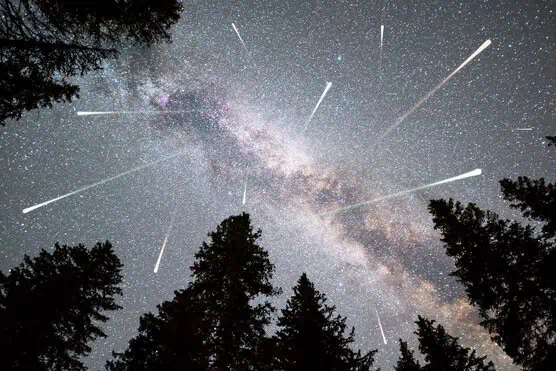If you’re looking for a breathtaking cosmic event that connects ancient skywatchers with modern-day stargazers, April 2025 is serving up a treat you won’t want to miss. The Lyrid Meteor Shower—an annual display of shooting stars with a legacy dating back over two millennia—is back and ready to light up our skies with its fiery trails and occasional fireballs.
A Time-Honored Event in the Sky
The Lyrids are one of the oldest documented meteor showers in history, with sightings dating back over 2,700 years.
That’s right—this cosmic event has been on record since 687 BC, when Chinese observers described stars “falling like rain.” It’s astonishing to think that the same shower they watched millennia ago will blaze through our skies this month. The Lyrids are named after the constellation Lyra, from which the meteors appear to radiate.
These meteors are pieces of debris left by Comet C/1861 G1 (Thatcher), a long-period comet that orbits the Sun roughly every 415 years. As Earth crosses the dusty trail left by this ancient traveler, the debris enters our atmosphere, creating streaks of light we call meteors.
When and Where to Watch the Lyrids in 2025
Timing and preparation are everything when it comes to witnessing a meteor shower, and this year’s Lyrids promise a remarkable show.
The shower is active from April 15 to April 29, but the peak night is April 21 into the morning of April 22. That’s when you’ll get the best chance to see the most meteors, with 10 to 20 meteors per hour expected under ideal dark-sky conditions.
For optimal viewing:
- Head out after 10:30 p.m., when the radiant point in Lyra is high enough in the sky.
- The best time to view is a couple of hours before dawn.
- Look toward the east, but keep in mind that meteors can appear in any part of the sky.
The waning crescent moon—only 27% full—will rise around 3:30 a.m., so it won’t interfere much with the viewing conditions. Try to get away from city lights, and give your eyes about 20–30 minutes to adjust to the dark.
What Makes the Lyrids So Special?
What sets the Lyrid meteor shower apart is its speed, brightness, and historical significance.
Lyrid meteors zip through the atmosphere at about 49 km/s (30 miles per second). That’s fast enough to make a dramatic streak across the sky, and some may even leave glowing trails that linger for a few seconds. These trails are called persistent trains, and they occur when the heat of entry ionizes the air around the meteor’s path.
Occasionally, the Lyrids produce fireballs—exceptionally bright meteors that can be as vivid as Venus and can cast shadows on the ground. These brilliant moments are what make the Lyrids so captivating for even casual observers.
There have also been rare instances of meteor storms, such as the Lyrid outburst of 1982, which delivered up to 90 meteors per hour. While no storm is predicted this year, the Lyrids are known for their surprises.
The Science Behind the Spectacle
Meteor showers like the Lyrids offer astronomers valuable clues about comets and the early solar system.
As these small particles burn up in our atmosphere, they reveal information about the chemical composition of the parent comet. NASA studies meteor showers from the ground, in the air, and from space-based platforms. These observations help forecast meteor activity, protect spacecraft, and improve our understanding of cometary material.
Moreover, by analyzing the paths and velocities of meteors, scientists can map the orbit of the parent comet and track changes in its debris stream. This helps researchers understand how comet tails evolve over time and how solar radiation affects their trajectories.
Meteor showers also serve as natural laboratories, offering insight into particle behavior, atmospheric interactions, and celestial mechanics.
Bonus Highlight: Visit the “City of Stars” – Globular Cluster M3
April’s night sky offers more than meteors—it gives us a glimpse at one of the most awe-inspiring deep-space objects visible with a backyard telescope.
Meet Messier 3 (M3), a globular cluster located about 34,000 light-years away, containing roughly 500,000 stars. Discovered by Charles Messier in 1764, M3 is a stellar metropolis located in the halo of our galaxy and is estimated to be between 11 and 13 billion years old.
Through binoculars, M3 looks like a fuzzy patch of light. With an 8-inch telescope, you’ll start to resolve hundreds of ancient stars, all tightly packed in a brilliant cosmic sphere.
To locate M3:
- First, “arc to Arcturus” using the handle of the Big Dipper.
- Then look slightly above and to the west to find the star Cor Caroli.
- M3 lies about one-third of the way between Arcturus and Cor Caroli.
Whether you’re a beginner or a seasoned astronomer, viewing M3 is an unforgettable experience—like peering into a galactic time capsule.
Planetary Highlights: A Sky Full of Wanderers
In addition to meteors and star clusters, April 2025 features striking planetary alignments that enrich the night sky.
- Jupiter and the Crescent Moon appear together on April 1 and April 30, visible just after sunset in the western sky.
- Mars shines reddish and bright throughout the month, high overhead in the evening. It aligns near the Moon on April 4 and 5.
- Venus becomes a brilliant morning star, visible in the eastern sky before sunrise.
- Saturn and Mercury join Venus later in the month, creating a stunning celestial grouping on April 24–25 along with the Moon.
These alignments make for excellent telescope targets and smartphone photography opportunities.
Final Thoughts: Don’t Miss This Celestial Show
This April, whether you’re in your backyard, on a mountain, or camped under rural skies, make time for the Lyrid Meteor Shower, the stellar M3 cluster, and the planetary alignments gracing our skies.



















